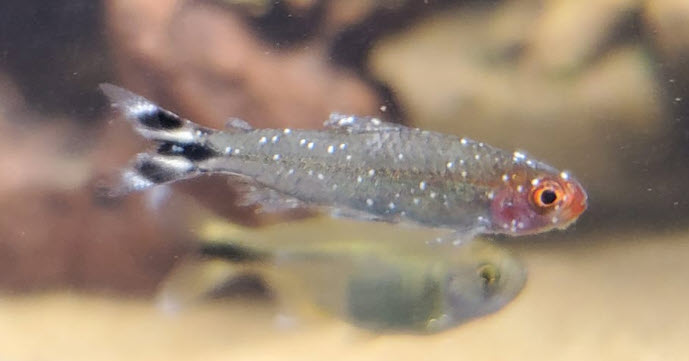
Ich simply is not normally fatal in ANY aquarium with an established filter because the established filter stops the ich organism. An established filter has a whole host of tiny, microscopic organisms on the surface of the filter media which can trap and literally eat the infectious ich theront. The longer a filter has been established the better it is at “eating” the theronts.
So in a well filtered aquarium the ich usually just runs its course with no fatalities. This is the reason so many “remedies” can be found for ich. ANY remedy, including such obviously useless things like garlic, will produce success most of the time. So the anecdotal “I’ve cured ich with XXX” abounds.
Even Joey fell to this trap. He admitted he had not had an attack of ich for twelve years, so obviously he has not had many attacks of ich on which to base a recommendation. He then went on to say that he had had success with Ich-X (formalin/malachite green). He also then went on to say he raised the temperature of his aquariums to 880 F. and thought about adding salt.
Ich-X (formalin/malachite green) is an effective treatment for ich. But Joey could have done no treatment and gotten the same results as his fish are just some very healthy brutes in relatively low stocking with crystal clear, very well filtered water and the number of infectious ich trophonts he introduced was low.
But Joey was lucky in one aspect. Formalin increases it’s toxicity considerably when the temperature is raised. So doing both adding formalin AND raising the temperature is risky.
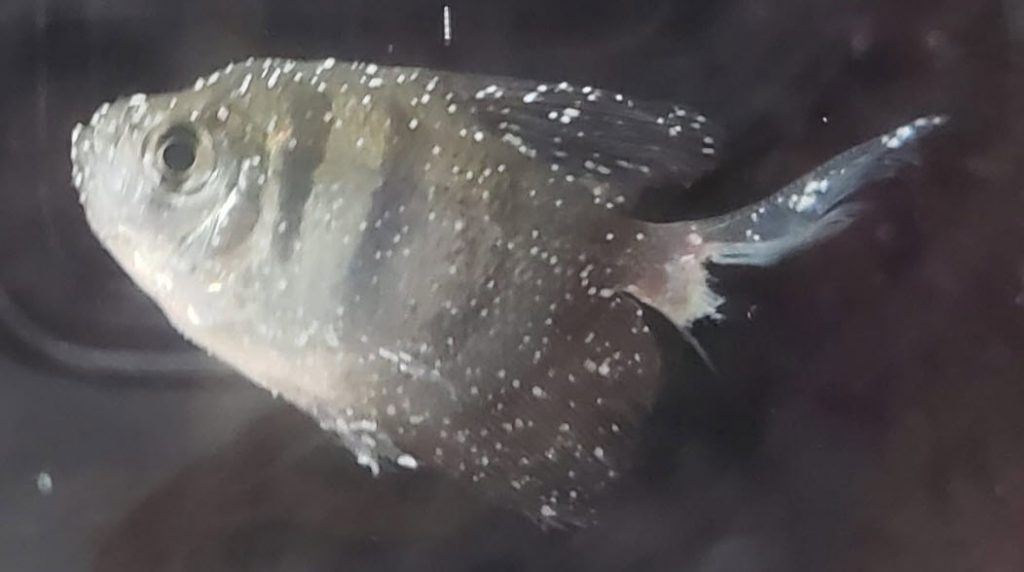
The ingredients and remedies claimed to cure ich include all the following:
The treatment used by all the experts like Cory of Aquarium Co-op:
- *Formalin/Malachite Green (Ich-X, Rid-Ich Plus, Blue Planet White Spot Remedy, AquaCare Anti-Fungus & White Spot, and Mardel QuickCure)
.
Treatments that also work fairly well per good University Research:
- *Formalin (NT Labs Koi Care Formaldehyde)(used by Public Aquariums)
- *Copper (Cupramine, Copper Power, Copper Aide, ESHA 2000 or Copper Safe)
- *Malachite Green (API Super Ich Cure, Nox-Ich, Tetra Ick Guard, Kordon Rapid Cure, Costapur by Sera, Waterlife Myxazin and Waterlife Protozin )
- Methylene Blue (Kordon Methylene Blue)
- *5,000 to 7,500 ppm salt (sodium chloride)
.
Treatments with NO research that says they work:
- bis (4-dimethylaminophenyl) phenylmethylium hydroxide (Sera med Protazol) (Colorless Malachite Green Hydroxide)
- Acriflavine (Jungle Labs Ick Care)
- Gentian Violet (Fritz FixIck)
- Aminoacridine
- Tris Aminomethane
- Aniline Green
- *Dibromohydroxymercurifluorescein (Merbromin)
- Ethacridine lactate (ESHA Exit)
- *Iodine
- *Potassium Permanganate
- *N-halamine
- *Cloramine T (Wipeout)
- *“Oxygen chlorine”
- Triethylene Glycol
- *Hydrogen peroxide
- *Acetic acid/hydrogen peroxide (Per Aqua and Desirox)
- *Peracetic Acid
- *Sodium Borate (Sera Ectopur)
- *Sodium Perborate
- *Trichlorfon
- *Dichlorvos
- *Amitraz
- *Cypermethrin
- Pyrimethamine
- Metronidazole
- *Glutaraldehyde (Paraguard)
- 1,4-Pentanediamine
- *N4-(7-chloro-4-quinolinyl)-NI,NI-diethyl (New Life Spectrum Ick Shield, Tetra Lifeguard)
- Polyvinylpyrrolidone
- *5-Nitroimidazoles
- *Nitrofurazone
- Quinine Sulfate
- Chloroquine Phosphate
- Napthoquinone
- Quinine Monohydrochloride (Clear-Ich by Aquatronics)
- 100% natural organic herbals (Ich Attack)
- “Proprietary herbal blend” (Herbtana)
- Garlic Extract
- Zingiberene (Ginger)
- Ar-curcumene
- Allin
- shogoal
- Tea-Tree Oil (Melafix)
- Bay-Tree Oil (Pimafix)
- Neem Oil
- Usmea Lichen
- Chitosan
- D-Limonene
- Manuka Oil
- Jalapeno peppers (capsaicin)
- Raising the temperature to 85 degrees
- Salt below 5,000 ppm
- *15,000 to 20,000 ppm salt baths for 20 to 60 minutes
- Vinegar
- 50% water changes every day
*medications which can be poisonous in overdoses.
Only the first six remedies have research which says they work. All of these remedies have scores of people on social media claiming they worked great for them. Most have manufacturer’s claims that they work against ich. Ah, the profit motive at work!
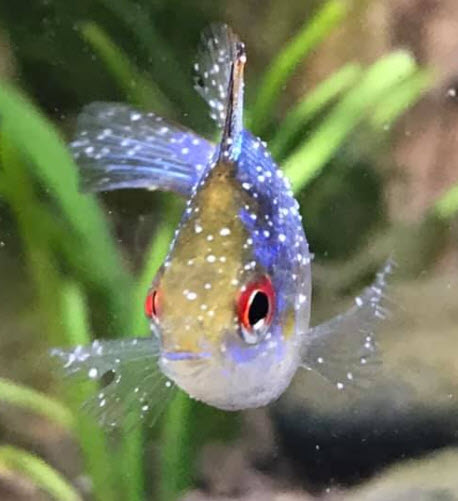
Metronidizole for Treating Ich
One very good illustration of the pervasiveness of the myths about ich treatment, one only need to look to metronidazole. There is a moderator on a Facebook forum who supposedly has a PhD in Marine Biology. This moderator keeps recommending metronidazole for the treatment of ich. The only problem is that metronidazole only works on organisms in an anaerobic environment, and ich is a very aerobic organism. Per Wikipedia:
“Metronidazole is of the nitroimidazole class. It inhibits nucleic acid synthesis by disrupting the DNA of microbial cells. This function only occurs when metronidazole is partially reduced, and because this reduction usually happens only in anaerobic bacteria and protozoans, it has relatively little effect upon human cells or aerobic organisms.”
So metronidazole simply can’t work against ich. So much for the PhDs. Note the many “expert opinions” from this individual indicate that this person is actually a fake account generated by the main supplier of metronidazole (Seachem). The account has disappeared from FaceBook, probably because the FaceBook algorithm detected a fake account. Welcome to the new profit minded world of social media.
Seachem Metroplex (metronidazole) and Waterlife Octozin (dimetridazole) both claim on their label to be a treatment for ich. Metronidazole and dimetridazole are from a class of drugs called Nitroimidazoles, So we can reference the paper “Synthetic Nitroimidazoles: Biological Activities and Mutagenicity Relationships”, Alka Mital, 2009. This paper confirms this class of drugs ONLY works against anaerobic organisms. Ich is an aerobic organism so it cannot be affected by Nitroimidazoles.
Abstract
“Parasitic and bacterial infections affecting the gastrointestinal tract represent a significant cause of morbidity and mortality worldwide. Nitroheterocyclic drugs have been available since the early 1960s for the treatment of anaerobic protozoa. The application of these drugs has widened, and they are presently used to treat anaerobic pathogenic bacteria and protozoa. 5-nitroimidazoles area well-established group of antiprotozoal and antibacterial agents that inhibit the growth of both anaerobic bacteria and certain anaerobic protozoa, such as Trichomonas vaginalis, Entamoeba histolytica and Giardia lamblia.”
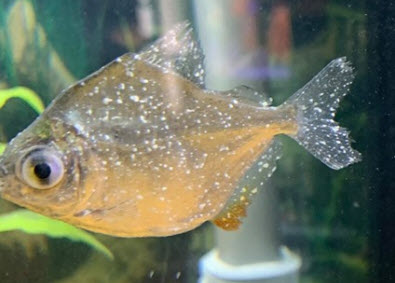
One research study found metronidazole to be totally ineffective against ich. “Efficacy of Sea Salt, Metronidazole and Formalin Malachite-Green in Treating Ichthyophthirius Multifiliis Infection in Mollies (Poecelia Sphenops)”, Maceda-Viega et. al., 2014. This study has some big deficiencies and is certainly not definitive but it still can be considered.
Paraguard as an Ich Medication
And then there is the profit motive. Seachem has a product called “Paraguard” which supposedly treats ich. Per the September 2019 FDA document provided by Seachem, Paraguard is 2.5% “glutaral”.
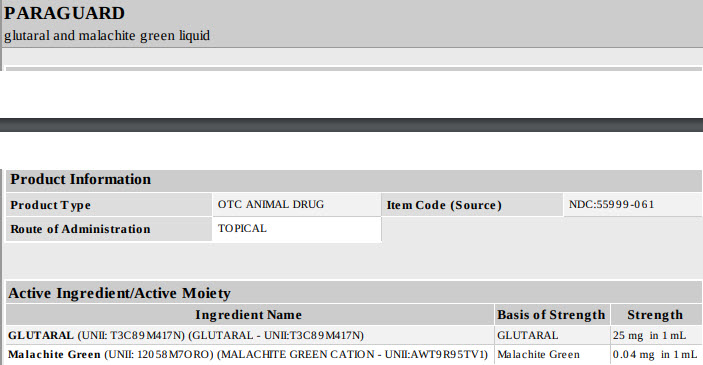
Per Pubchem “glutaral” is a brand name for glutaraldehyde. Per OSHA: “Glutaraldehyde is a toxic chemical that is used as a cold sterilant to disinfect and clean heat-sensitive medical, surgical and dental equipment.” Glutaraldehyde is six times more toxic to fish than formaldehyde (Zhou et. al. 2016). It has killed fish and plants in aquariums when used in even slight overdoses. There is NO research backing glutaraldehyde as a treatment for ich.
Yet post this on social media and a host of people will come out saying they have treated their fish that have ich with Paraguard and the ich went away with no fish deaths. These hobbyists simply had mature filters which removed the infective ich theronts and their fish survived and the ich went away. Again, this is just another of the many ineffective medications which only “work” when there is an established filter.
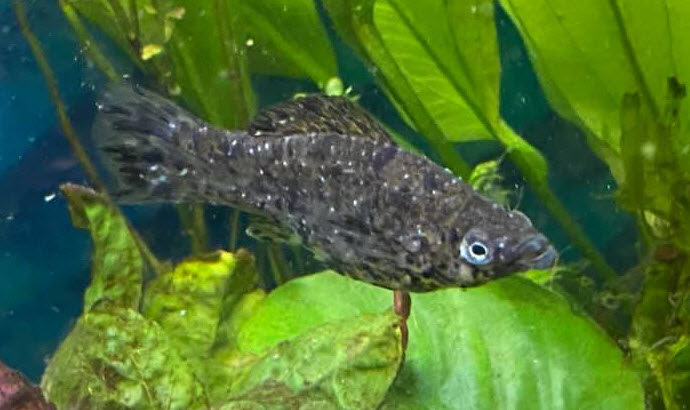
University Research
Note that some of the ingredients in the list of totally ineffective medications above have some “university” backing as remedies. The universities are invariably small universities or third world universities where the ethics of the research is very questionable. If a professor is offered a ton of money by the maker of xxxx to study “How effective xxxx is on treating ich?”, what do you think the conclusions of his research are going to be?
Disinfectants
Note also that some of these ineffective products are what are called “disinfectants”. Disinfectant will kill all living cells they come in contact with. So at some level these disinfectants will kill the ich organism. The problem is that at that same level they will kill the fish and the plants in an aquarium. Whoops! The ONLY disinfectant that seems to selectively inhibit and kill the ich organism at a level below toxicity to fish is formalin/malachite green.
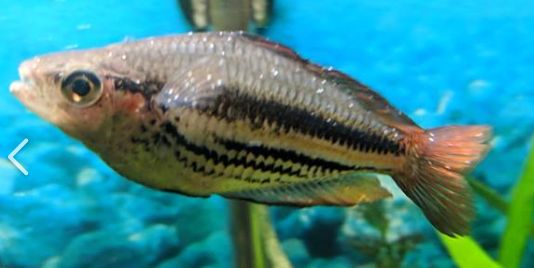
Water Changes to Treat Ich
Directions on Ich-X medication say to do a 33% water change before adding the medication (i.e. do a water change at least every 24 hours). This water change is completely ineffective and does very little for the process.
Let us take an aquarium that is infected with ich and make some assumptions. Let us assume there are 500 tomants (which live three days) per day in the substrate producing 400 ich theronts when they burst and die. This is a loading of 200,000 free swimming infectious theronts per day going into the water. At 78 degrees these theronts will live for two days. Let us say that under “poor” case conditions (i.e. with only limited filtration) the 200,000 theronts will produce 1,000 tomants in the substrate (4 days later) to continue the process, 500 the first day and 500 the second day of the theronts lives. Then a chart can be set up by generation:
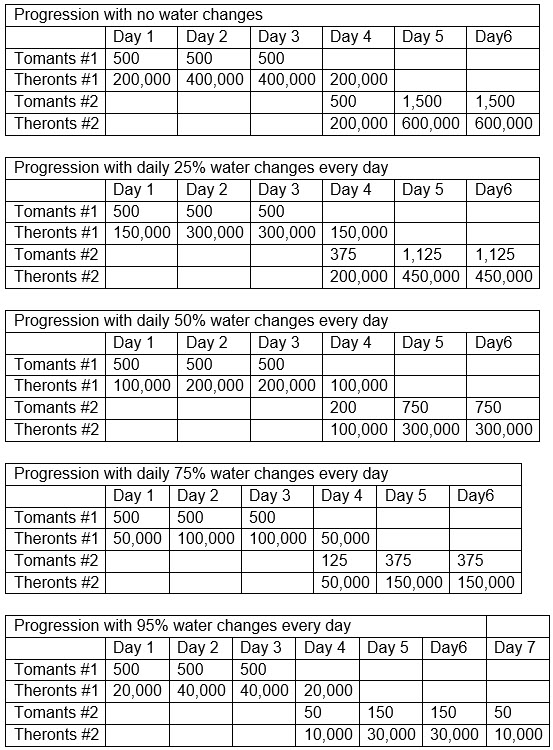
A 50% change every day had very little effect on the ich. Once must get up to a 95% water change before there is significant reductions in the infectious ich organism. Now 95% water changes WILL HELP with ich and will NOT hurt the fish, contrary to popular mythology.
Studies with Limited Application
There are literally hundreds of studies on medications and ich. Most of them are very well done but have some severe limitations. None of them was done on aquariums with functioning filtration systems. Many of them looked at baths rather than in tank treatments. And many of them has VERY limited application.
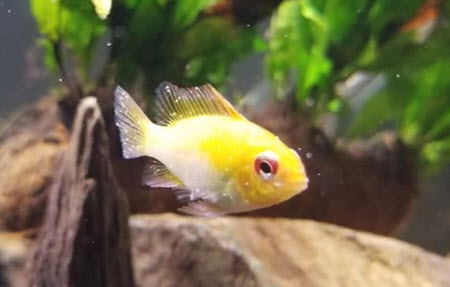
Unfortunately takes a a bit of sleuthing to “separate the wheat from the chaff”. For instance the study “Heavy infection of Ichthyophthirius multifiliis in Striped Catfish and its Treatment Trial by Different Therapeutic Agents in a Control Environment”, Mamun, 2019 .
“Infected fishes were transferred and equally distributed to the 0.45 m3 glass aquaria and treated with three treatments: (T1) methylene blue + salt; (T2) raising temperature with salt; and (T3) formalin + malachite green. The best fingerling survival (55 ± 9.36%) was obtained by elevated water temperature with salt in T2.”
On the surface this would seem to be a very good study which showed heat and salt in combination works well, better than formalin/malachite green.. This conclusion would be in error. The study looked at ONLY combinations of treatments. So the conclusion with regard to the T2 combination can be any one of three things:
- 1% salt somewhat works
- 85 degrees F (26 degrees C.) somewhat works
- the combination of 1% salt and 85 degree heat somewhat works
We have already shown a whole host of studies where 1% salt works somewhat well. The percentage of fish which survived in this study in the T2 group was very close to the percentage of fish that survived in the salt only studies (56%). So the first conclusion is the legitimate one. Heat had nothing to do with it.
And the “ineffectiveness” of the formalin/malachite green is also no surprise. These researchers used treatments of formalin/malachite green every two days (48 hours) at 76 degrees F (24C). There are a whole host of papers saying formalin/malachite green only works at 76 degrees if applied at least every 24 hours. These papers all say every 48 hours simply doesn’t work at all.
So this study actually ONLY confirms the many other studies which say that salt will somewhat work. It confirms nothing else! This is why caution is needed when looking at studies.
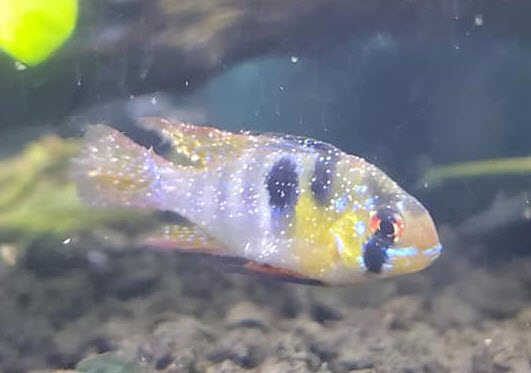
Ich in more Depth
Ich is the most common fish disease and warrants a more in-depth discussion. The following chapters are devoted to this common fish disease:
10.2.2.1. Ich in More Depth
10.2.2.2. Immunity of Fish to Ich
10.2.2.3. Ich Medications
10.2.2.4. Ich Medications in More Depth
10.2.2.5. Ineffective Ich Medications
10.2.2.6. Using Filtration to Remove Ich
10.2.2.7. Treating Ich with Heat
.
Return to Disease Menu
Return to Skin Protozoan Menu
Return to Ich Menu
.
Aquarium Science Website
The chapters shown below or on the right side in maroon lead to close to 400 articles on all aspects of keeping a freshwater aquarium. These articles have NO links to profit making sites and are thus unbiased in their recommendations, unlike all the for-profit sites you will find with Google. Bookmark and browse!
.

kurt W. schnepf says
perhaps the water change is recommended with ich x to improve water quality and counter any negative effects of the treatment. company should clarity purpose of water change.
Dave says
In reply to Gus …. Metronidazole ONLY works to shut done a metabolic pathway used ONLY by anaerobic organisms. From Wikipedia — “Trichomonas vaginalis is an anaerobic, flagellated protozoan parasite” —- “Giardia is a genus of anaerobic flagellated protozoan parasites” Now anaerobic conditions and pathologies can present themselves anywhere inside the body (i.e. lungs and brain) and metronidazole can be used to treat those anaerobic pathologies. But ich is a strictly aerobic organism. So it doesn’t even have the metabolic pathway that metronidazole attacks. So my comment that ich is not affected by metronidazole is correct.
Gus says
I think your website is awesome, compared to other information out there. Thanks for providing this resource. As an Infectious Disease doctor, your section on Ich and metronidazole, respectfully, is not the most accurate. Now I confess, I am not an expert in veterinary medicine. For humans, I use Metronidazole almost every day in my practice. I use it for anaerobic bacteria but also protozoa (e.g. Giardia, Trichomonas, etc.). It is effective in parts of the body that are not anaerobic, such as lung, brain, etc. Whether it works for Ich is another question. I don’t know. Appears evidence is lacking? But that doesn’t mean it is ineffective, just means needs further study, as there is biological plausibility. Thank you.